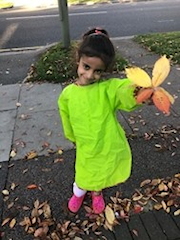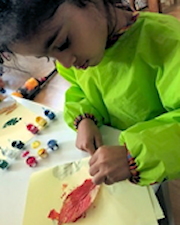Play and Leisure

Why is play important?
Play is how children begin to understand themselves and the world around them. When a newborn watches their parent/carer’s face and hears them talking and singing, not only does this secure the strong bond between parent/carer and child, but it is also the very important beginning stages of communication and socialisation. This is why parent or carer’s friendly face, chatter and attention is the best toy a child can have in their first three months of life.
As babies start exploring toys and objects around them; they begin to discover their impact on their environment, like banging two objects together to make a noise. They learn that objects have different properties, different effects, different textures – all crucial things to know! As they begin to crawl, stand and walk, they now have more opportunity to explore more of what’s around them as well as learning how their bodies work and move.
Play can help with:
- physical development
- cognition and though process
- communication and social interaction
- imagination and creativity
- emotional wellbeing
Providing your children with opportunity to learn all these new things doesn’t mean you have to buy expensive toys or follow strict ‘rules’ as to what your child should be doing when. Playing is the most important occupation your child has and can be achieved solo and shared with you – you can follow their lead as you learn to play together. All children need to be able to stretch to their own limits to develop spatial awareness and coordination and build confidence in their own abilities.
Ideas for play include:
1. Sensory Play
Sensory play encourages exploration through touch, sight, smell, sound, and sometimes taste. It’s crucial for cognitive development and helps children build their understanding of the world around them.
- Sensory Bins:
2. Gross Motor Play
Gross motor skills involve the large muscles of the body, helping children develop strength, coordination, and balance. These activities are great for physical health and overall motor development.
- Obstacle Course: Set up an indoor or outdoor obstacle course using cushions, tunnels, cones, and other materials to create a course that children can crawl, jump, balance, or climb through.
- Ball Play: Throwing, catching, and kicking a soft ball help improve hand-eye coordination and physical strength. Vary the size and texture of the ball for different sensory experiences.
- Dancing and Movement: Put on some music and have a dance party! This promotes coordination, rhythm, and self-expression.
3. Imaginative Play
Imaginative or pretend play is essential for social and emotional development. It encourages creativity, problem-solving, and empathy, as children create and act out different roles and scenarios.
- Pretend Kitchen: Set up a toy kitchen with pots, pans, and pretend food. Children can role-play cooking, serving, and sharing meals, which helps develop social skills like turn-taking and communication.
- Dress-Up: Provide costumes or old clothes for children to dress up as different characters—whether it’s a superhero, doctor, or animal. This encourages creativity, storytelling, and role-play.
- Animal Games: Pretend to be different animals, exploring how they move and sound. This can help with learning animal names and sounds, as well as developing motor skills through imitative movements.
4. Social Play
Social play is all about engaging with others. Whether it’s cooperative play with friends, siblings, or caregivers, these activities foster communication, sharing, and teamwork.
- Building Together: Work together to build a structure with blocks, Lego, or large foam bricks. This encourages cooperation, problem-solving, and teamwork.
- Interactive Games: Games like “Simon Says,” “Hide and Seek,” or “Ring Around the Rosie” help children practice following directions, taking turns, and understanding social cues.
- Group Storytelling: Sit in a circle and start a story, letting each child add a part. This helps with language development, creativity, and turn-taking.
5. Cognitive Play
Cognitive play helps develop problem-solving, memory, and early learning skills. These activities stimulate brain development and encourage children to think critically and creatively.
- Sorting and Matching:
6. Creative Arts Play

Artistic activities not only provide a fun outlet for creativity, but they also help with fine motor skills, hand-eye coordination, and sensory development.
- Painting and Drawing: Provide different tools for children to express themselves, from crayons to watercolours to chalk. Let them experiment with colours and shapes, encouraging self-expression and creativity.
- Collage Making: Use paper, fabric, stickers, and other craft materials to make a collage. This promotes fine motor control and creativity while exploring textures and patterns.
- Nature Art: Go on a nature walk and collect leaves, flowers, rocks, or sticks. Once back, create a nature-inspired artwork or collage. This also fosters a connection to the natural world.
7. Language Play
Language play helps children develop communication skills, vocabulary, and listening skills in a fun and engaging way.
- Storytime with Puppets: Use puppets or stuffed animals to act out stories. Encourage children to create their own stories and dialogue. This helps with language development and creativity.
- Rhyme Time: Sing nursery rhymes, make up new ones, or play rhyming games. Rhymes help with phonological awareness, which is key for early reading skills.
- Interactive Books: Choose books with flaps, textures, or sounds to engage children during story time. Ask questions about the pictures and encourage them to "read" along with you.
8. Fine Motor Play

Fine motor skills involve the smaller muscles of the hands and fingers. These skills are important for tasks like writing, drawing, eating, and self-care.
- Beading or Threading: String beads onto a cord or use laces to thread through holes in cards or fabric. This helps improve hand-eye coordination and finger dexterity.
- Sticker Play: Let children peel and stick stickers on paper. This activity strengthens hand muscles and fine motor control.
- Cutting with Scissors: Allow children to practice cutting paper or other materials with safety scissors. This builds hand strength and coordination.
Play and Learning Go Hand in Hand
Each of these play activities helps children develop in a well-rounded way. As they explore through play, they build essential skills like communication, motor coordination, social interaction, and creativity—all while having fun!
The best part? Play doesn’t need to be complex or expensive—it can be as simple as a game of pretend, some finger paints, or a dance party. Let your child’s imagination guide the way, and you’ll be amazed at how quickly they grow and learn through these playful experiences!
Learn more about stages of development here:
Further Information and Ideas for Play:
EI SMART – EiSMART Toy and Play ideas Preterm to 3 years old
BBC Tiny Happy People - Tiny Happy People 0-5 year olds
BBC Tiny Happy People - Tiny Happy People 0-5 year olds
Better Health - Better Health Activities 5+ years
Please also visit our Out and About and Physical Skills page for more information.
Last updated01 Apr 2025


